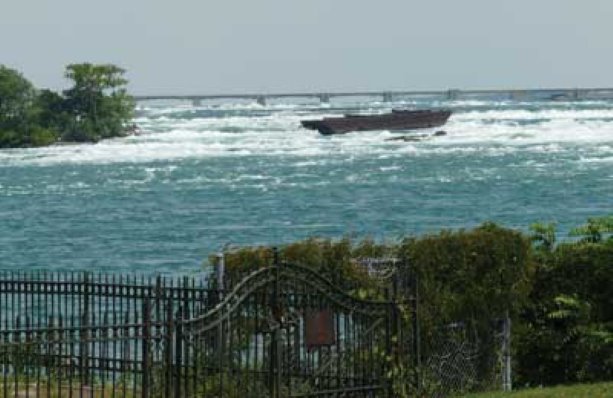On August 6, 1918, a fully loaded scow was being pulled upstream by the tugboat Hassayampa when the tug hit another sand bar. The scow breasted the waves and snapped the cable connecting it to the tug.
Ninety years later, people still marvel at the miraculous rescue of two construction workers.
That’s because millions of tourists each summer wonder about the rusting iron barge sitting precariously above the Horseshoe Falls in the rippling rapids of the Niagara River.
Gustave Loftberg and James Harris were operating that sand scow for Great Lakes Dredge and Dock of Chicago.
Their job was to remove a sand bar that had formed near the mouth of an intake channel for an American power plant.
On August 6, 1918, the fully loaded scow was being pulled upstream by the tugboat Hassayampa when the tug hit another sand bar. The scow breasted in the waves and snapped the cable connecting it to the tug.
With the two workers onboard, the scow was quickly seized by the swift current and swept toward the Canadian shore. The barge is 80 feet long and 30 feet wide, with doors in the bottom to dump its dredging load. Its walls are airtight compartments that keep the scow afloat when the bottom doors are open.
Loftberg and Harris, both 51, were aboard the scow to crank the doors open and closed.
They opened the bottom doors in hopes of slowing their drift downstream in the 109km/h current.
The load dumped, but the scow kept racing towards the falls. Soon the men could hear the roar and see the mist rising from the massive Horseshoe Falls. Harris tied himself to the barge in fear of falling overboard in the rapids. Loftberg, a Swedish mariner, tied himself to a barrel and planned to jump off the barge as it approached the brink.
Just when all hope seemed lost, the scow grounded on some rocks only 760 metres above the precipice. It rested 260 metres from the Canadian shore, directly opposite the Toronto Power Plant.
Hundreds of spectators had been watching the scow’s dance with death and now that it sat precariously on the rocks, a rescue effort took shape. The Niagara Falls Fire Department was first on the scene about 3 p.m. with its horse-drawn rigs.
From the roof of the Toronto Power Plant they fired a grappling gun, but the rope fell 152 metres short of the barge. A raft was devised to float a rope to the barge from upstream, but that failed, too.
A call went out to the U.S. Coast Guard base at Youngstown, N.Y. on the Lake Ontario shore. Five soldiers responded with a larger grappling gun. From the roof of the Toronto Power Plant they fired out a small rope that draped over the barge.
James and Loftberg used it pull out a larger rope. But the bigger rope was heavy and although the stranded men were able to rig it to the winches that opened and closed the scow’s bottom doors, it was still slow going.
The heavy rope sagged into the river and the rescuers feared it would dislodge the scow from its rocky perch. One hundred men were put on the rope to keep it taunt and out of the water.
By 2 a.m. the big rope was secured to the barge. A bosun’s chair was attached and slid out towards the scow. But it got stuck halfway when it tangled with a smaller attached rope.
William “Red” Hill was just back to his native Niagara Falls after being wounded as a Canadian soldier in the First World War. He was a renowned river man and daredevil. He would save 28 people from drowning in the Niagara River before his death at age 54 in 1942.
When the chair snagged, 30-year-old Hill volunteered to shimmy out on the rope going hand-over-hand to dislodge the chair. He hung above the raging rapids by his feet and one hand for two hours as he worked to clear the chair.
Huge floodlights were brought in to illuminate the rescue scene and thousands watched from the river bank. After two hours and no success, Hill reversed along the rope to the power plant roof and waited for daylight.
One-metre-high letters were used to spell out a message to the stranded men that the rescue attempt would continue at daybreak.
At first light, Hill again shimmied out on the rope and was able to free the chair. He got close enough to the scow to shout directions to Harris and Loftberg on how to use the chair.
Hill again came back to the roof and by 10 a.m. Harris, weak and terrified was pulled across on the rope to safety.
Loftberg soon followed.
After a hearty breakfast at the best hotel in town, newspaper interviews and a good night’s sleep the two men were back to work the next day, but Harris vowed never again to work on the river. He never visited Niagara Falls again and never spoke of his ordeal.
Loftberg became a media darling and gave lectures in New York State about his adventure on the river.
The defiant scow still sits where it lodged that August day 90 years ago.
It has outlived endless predictions, bets and speculation about how long it could resist the tug of the river and 90 winters of ice chunks pounding its hull.
A shrub now grows out of the hull. Some of its river-side wall has disappeared. Niagara Parks Commission officials predict the scow won’t survive to celebrate its 100th anniversary.











Recent Comments
comments for this post are closed